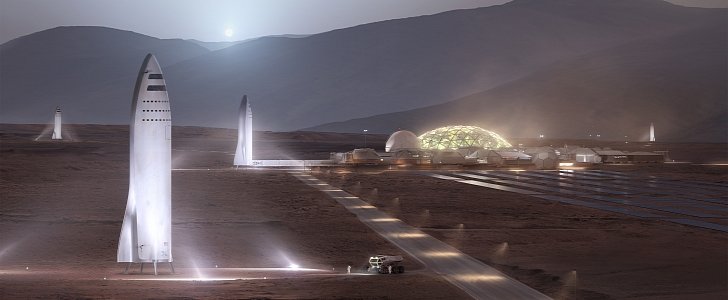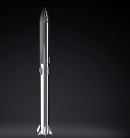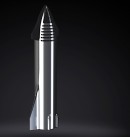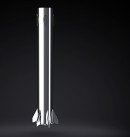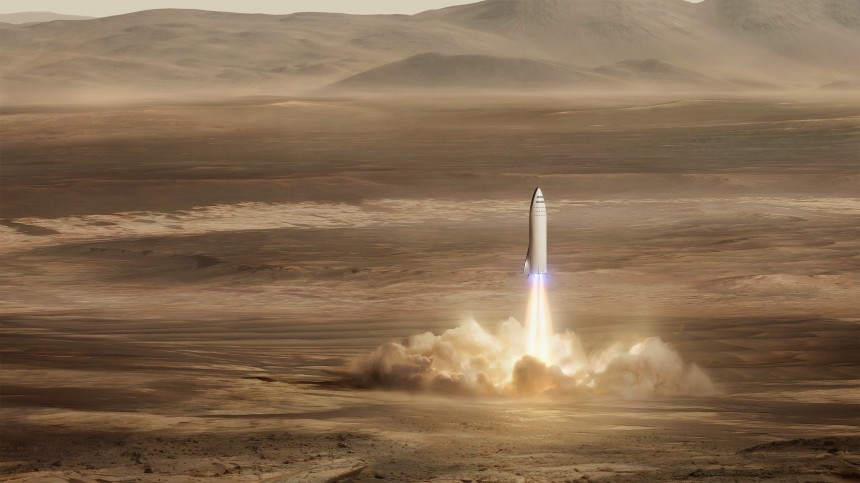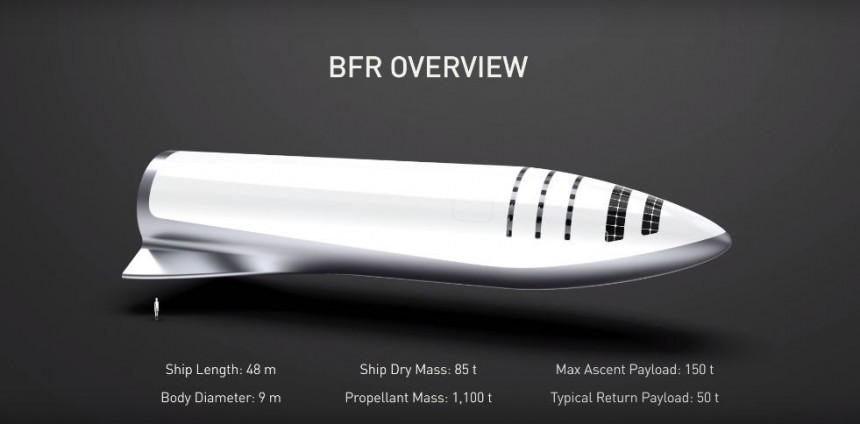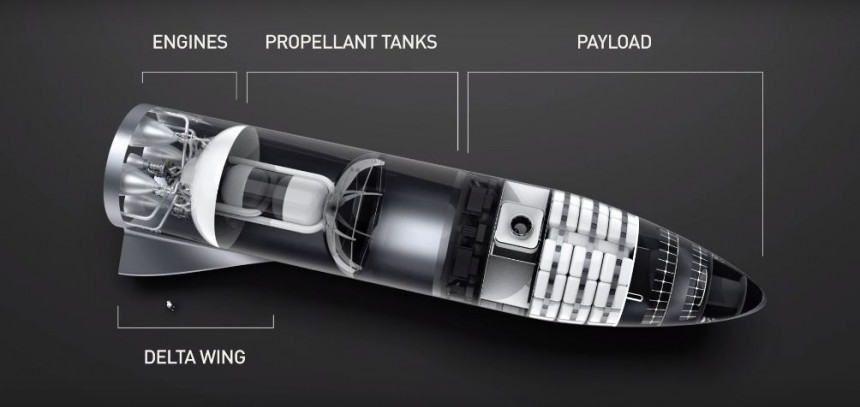Back in 2018, SpaceX CEO Elon Musk posted on Instagram a photo that he captioned “main body tool for the Big Falcon Rocket (BFR) interplanetary spaceship.” The image shows a big cylinder with six holes in it, the template on which parts of what was then known as the BRF assembly would be constructed.
The BFR, first debated in 2017, was one of the many ideas people who dream of trips to Mars had over the years. Musk, however, is in the unique position of actually being capable of doing something about it. Five years later, we know the contraption as the Starship, a precursor to the actual tech that'll expand humanity to a proper alien planet, and the launch system that'll eventually make history.
Essentially, the Starship assembly is comprised of a Super Heavy booster and a ship mounted on top of it, called... Starship. The purpose of the combo is to serve as transportation to the International Space Station, to the Moon, to Mars, and if we really stretch our imagination enough, even to and from locations on Earth, on ballistic orbits that should become the highways of the future.
Powering the Mars Starship is the said Super Heavy booster, reusable in nature because this is how SpaceX likes to roll. As with any other such tech, it will help the ship carried on top defeat Earth's gravity and get on its merry way. Back when the first details of the project were announced, the height of the booster was set at 58 meters (190 feet). Now, the dimensions have grown, and we're looking at a rocket 69 meters (230 feet) tall.
Its design is inspired by that of the Falcons currently flying, and used to send various items into orbit, including a Tesla Roadster. A number of 33 Raptor engines will be pushing it up and at 7,590 tons-force, it should become the most powerful rocket ever flown.
Before getting there, though, a lot of other things still need to go right. These past few years, SpaceX has been busy testing precursors of the rocket, trying to get the landing right. The last Starship booster to fly, SN15, managed to do that and now the company is getting ready for the first orbital test flight. At the moment, it's unclear when it will happen, but there's a good chance we'll see that in 2023.
All this effort of making a working Super Heavy booster has only one goal: to push what was once the Big Falcon Rocket ship on its way to Mars. Now simply called Starship, it suffered a few changes from what was announced back in 2018. And we also don't actually have one in the real world yet.
When this does happen, the bullet-like construction will increase the height of the Starship assembly by an extra 50 meters (164 feet). The diameter of the thing is about 9 meters (30 feet) and offers a pressurized volume greater than the one on the main deck of an Airbus A380.
We don't yet know all the details about the ship's interior, but it can theoretically be configured to serve various transport needs. For journeys to Mars, SpaceX once talked about fitting some 40 cabins for the crew in there, but also common areas. Further down the Starship, a central storage space for supplies is being considered, but also a galley. Because traveling through space is dangerous on account of radiation, a shelter to protect astronauts from solar storms will also be included.
The fuel tanks will occupy more than half of the ship. Each one is capable of holding 240 tons of fuel and the other 860 tons of liquid oxygen for traveling needs.
The Starship has its engines too, Raptors as well. It's unclear how many of them will be used, but Ship 24, which will take to the sky for the first orbital test, will have six of them. Initial plans talked about four vacuum engines to be used for actual space travel and two others in the atmosphere. In September 2018, Musk hinted SpaceX might add an additional, seventh engine and replace the vacuum ones with atmospheric units.
As said, the booster and the ship will together transform into the Starship. In terms of total size, it is close to the biggest rocket ever made by man, the Saturn V. But whereas it does not exceed its height, Starship does beat the Saturn in terms of payload capacity.
Flying this thing will be similar to how things presently happen in space exploration. The booster will assist the ship in exiting the Earth’s gravity and it will then return to Earth in a fashion not unlike that of current boosters. The ship, on the other hand, will continue its way to Mars, carrying at first only cargo, and later a human crew as well.
When it arrives at its destination, the ship will enter the Martian atmosphere at 7.5 km per second (16,777 mph). Contents of the ship would be protected by a heat shield, while landing would be handled by the thrusters fitted on the ship. Current plans talk of two Starships launching toward the Red Planet carrying cargo in preparation for human arrival (that was supposed to happen by 2022). Shortly after that, two other ships, this time crewed, are set to depart.
SpaceX plans to use its next-generation rocket for ISS supply missions as well, but also for long-distance travel on our home planet. Using ballistics, the rocket is supposed to be able to significantly reduce travel times. For instance, says SpaceX, a nearly 4,000 km trip (2,485 miles) from Los Angeles to New York would take only 25 minutes, compared to the current flight time of nearly five and a half hours.
Essentially, the Starship assembly is comprised of a Super Heavy booster and a ship mounted on top of it, called... Starship. The purpose of the combo is to serve as transportation to the International Space Station, to the Moon, to Mars, and if we really stretch our imagination enough, even to and from locations on Earth, on ballistic orbits that should become the highways of the future.
Powering the Mars Starship is the said Super Heavy booster, reusable in nature because this is how SpaceX likes to roll. As with any other such tech, it will help the ship carried on top defeat Earth's gravity and get on its merry way. Back when the first details of the project were announced, the height of the booster was set at 58 meters (190 feet). Now, the dimensions have grown, and we're looking at a rocket 69 meters (230 feet) tall.
Its design is inspired by that of the Falcons currently flying, and used to send various items into orbit, including a Tesla Roadster. A number of 33 Raptor engines will be pushing it up and at 7,590 tons-force, it should become the most powerful rocket ever flown.
All this effort of making a working Super Heavy booster has only one goal: to push what was once the Big Falcon Rocket ship on its way to Mars. Now simply called Starship, it suffered a few changes from what was announced back in 2018. And we also don't actually have one in the real world yet.
When this does happen, the bullet-like construction will increase the height of the Starship assembly by an extra 50 meters (164 feet). The diameter of the thing is about 9 meters (30 feet) and offers a pressurized volume greater than the one on the main deck of an Airbus A380.
We don't yet know all the details about the ship's interior, but it can theoretically be configured to serve various transport needs. For journeys to Mars, SpaceX once talked about fitting some 40 cabins for the crew in there, but also common areas. Further down the Starship, a central storage space for supplies is being considered, but also a galley. Because traveling through space is dangerous on account of radiation, a shelter to protect astronauts from solar storms will also be included.
The Starship has its engines too, Raptors as well. It's unclear how many of them will be used, but Ship 24, which will take to the sky for the first orbital test, will have six of them. Initial plans talked about four vacuum engines to be used for actual space travel and two others in the atmosphere. In September 2018, Musk hinted SpaceX might add an additional, seventh engine and replace the vacuum ones with atmospheric units.
As said, the booster and the ship will together transform into the Starship. In terms of total size, it is close to the biggest rocket ever made by man, the Saturn V. But whereas it does not exceed its height, Starship does beat the Saturn in terms of payload capacity.
Flying this thing will be similar to how things presently happen in space exploration. The booster will assist the ship in exiting the Earth’s gravity and it will then return to Earth in a fashion not unlike that of current boosters. The ship, on the other hand, will continue its way to Mars, carrying at first only cargo, and later a human crew as well.
SpaceX plans to use its next-generation rocket for ISS supply missions as well, but also for long-distance travel on our home planet. Using ballistics, the rocket is supposed to be able to significantly reduce travel times. For instance, says SpaceX, a nearly 4,000 km trip (2,485 miles) from Los Angeles to New York would take only 25 minutes, compared to the current flight time of nearly five and a half hours.
